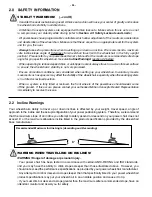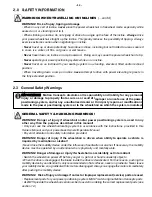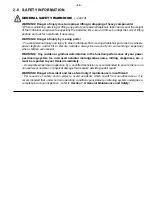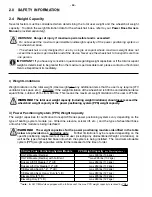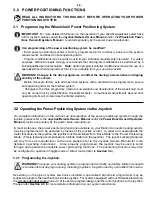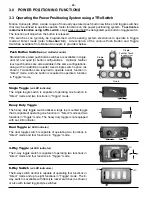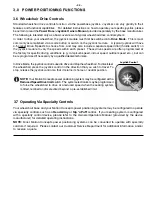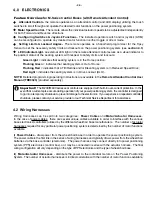
- 24 -
4.0
4.0
ELECTRONICS
ELECTRONICS
4.2 Wiring Harnesses
Wiring Harnesses can be split into two categories:
Power Cables
and
Motor/Actuator Harnesses.
In the case of power cables, there are several unique cables available in order to interface with the various
base electronics (controllers) utilized by the different wheelchair base manufacturers. The number of actuator
harnesses required for any particular power positioning system is determined by the number of motor functions
available.
i) Power Cables
- draw power from the wheelchair base in order to operate the power positioning system.
The power cable is the first link in the series of wiring harnesses and typically draws power from the wheelchair
batteries via the base controller (electonics). The power harness may connect
directly
into power positioning
system (PPS) electronics (control box), or it may be connected
in-series
with the actuator harness. The final
wiring configuration will vary depending on the type of PPS electronics and the type of wheelchair base.
ii) Motor/Actuator Harnesses
- distribute the power to the individual motors on the Power Positioning
System. The number of actuator harnesses is in direct correlation with the number of motor functions available.
Feature Overview
for M-Series Control Boxes (with Remote Attendant Control):
w
Attendant Controls
- the remote operates as an attendant control (and LED display) utilizing the touch
switches to scroll through and operate the desired motor functions on the power positioning system.
w
Motor Speed Control
- The remote allows the individual actuator speeds to be adjusted/set independently
for both Forward and Reverse directions.
w
Configuring Switches & Joystick Functions
- The installed operator switch and/or joystick (ASM)
can be reconfigured to operate any desired motor function in either toggle or direct mode.
w
Setting Limits & Lockout Angles-
The remote operates as a hand-held programmer for the Tipsy
Sensor to set the necessary safety limits and lockouts on the power positioning system (see
section 4.3
)
w
LED Indicator Light
- an external LED light on the remote attendant control serves as a visual indicator to
the position/ status of the seating system with respect to safety limits and lockouts:
Green Light
= indicates that seating system is in the Home position;
Flashing Green
= indicates that seating system is Out of Home;
Flashing Red
= indicates that a TIlt/Recline and/or Elevating system is in Reduced Speed Drive;
Red Light
= indicates the seating system is in Drive Lockout (DLO)..
NOTE:
Detailed programming/operating instructions are available in the
Remote Attendant Control User
Manual (TRD0323)
(provided separately)
Important!
The M200/M600 series seat controls are equipped with built-in over-current protection. In the
event that a current spike occurs during operation of your power positioning system, the controller is designed
to go into a temporary shutdown to prevent damage to the electronics. If you experience a repeated controller
shutdown, please contact your service provider or our Technical Service Department for assistance.
Summary of Contents for F Series
Page 2: ......


